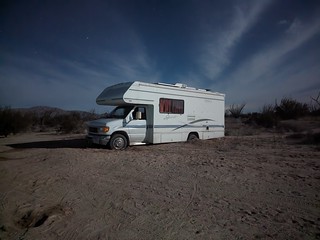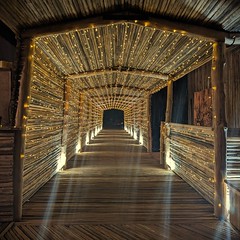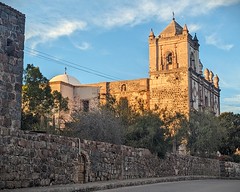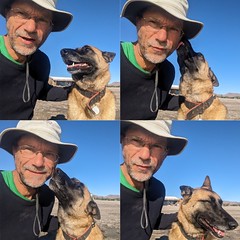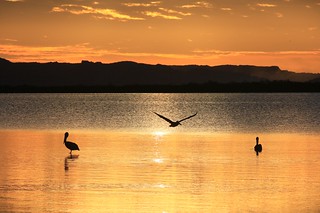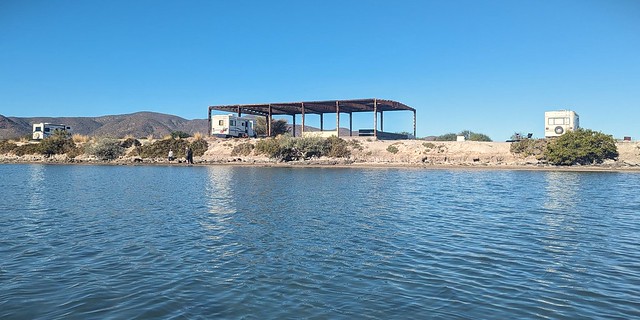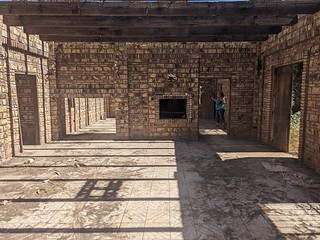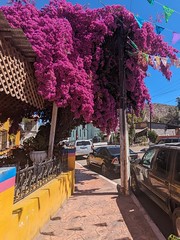Before I get into my travels east to Texas, I thought I’d discuss what I think of Baja after having been there for six weeks. It’s definitely not enough time for me to be an expert on the area by any stretch, but it is long enough to start getting the feel for the place. I’ll be sprinkling this post with my favorite pictures of the trip too. If you are new here, you may want to read my posts on Baja first, starting here. Now, onto my thoughts!
All of these musings can be stated as “your mileage may vary”, as we only made it 2/3rds of the way down Baja to Mulege. The points further south definitely have more people and probably some different conditions to what we had. Also, we did not go really remote down miles of gravel roads off the highway to get to remote beach spots. We stayed generally close to civilization and/or the main highway. If you are going more remote, just expect even less services catering to RVers as a given.
One of the biggest surprises for me was the lack of English spoken in Baja. I had it in my head that Baja would be similar to Europe, with lots of English as a second language, especially by anyone who is dealing with tourists on a regular basis. The reality is that an English speaker is the exception to the norm, among regular folk, authorities, and business owners. Knowing some Spanish is very helpful, especially if you get in a bit of trouble. We did see a bit more English spoken in the bigger tourist areas like San Felipe and Mulege, but don’t expect a lot of English just travelling along Highway 1. If you are on your own, or in a group with no Spanish spoken, I would be extra cautious about venturing down Baja. You can do it, but know that anything not straightforward will be extra difficult with the language barrier added in.
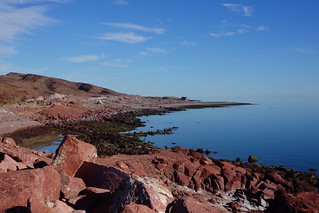 Campgrounds in Baja were more primitive than I expected overall. I thought there would be more full service campgrounds but no, the most common campground is the no service spot on the beach, around $10 a night, give or take a bit of spring break inflation or haggling. Even when you do have services, expect them to be pretty threadbare. We never hooked up to water the whole time we were down there for fear of contaminating our lines. Power can be dicey too – expect everything to be like it was wired by your crazy neighbor down the street. Even sewer dump was pretty disgusting at times, a hole in the ground with sewage water way below, or a funnel leading to a pipe that tends to back up from heavy flow. Generally the campgrounds were not very pretty, most of the beauty was more despite the campground rather than being enhanced by the campground. Frankly, if someone like KOA (KOM?) decided to setup a network of campgrounds down the Baja peninsula, they would be instantly busy assuming they could setup to the same high standards they have in the States.
Campgrounds in Baja were more primitive than I expected overall. I thought there would be more full service campgrounds but no, the most common campground is the no service spot on the beach, around $10 a night, give or take a bit of spring break inflation or haggling. Even when you do have services, expect them to be pretty threadbare. We never hooked up to water the whole time we were down there for fear of contaminating our lines. Power can be dicey too – expect everything to be like it was wired by your crazy neighbor down the street. Even sewer dump was pretty disgusting at times, a hole in the ground with sewage water way below, or a funnel leading to a pipe that tends to back up from heavy flow. Generally the campgrounds were not very pretty, most of the beauty was more despite the campground rather than being enhanced by the campground. Frankly, if someone like KOA (KOM?) decided to setup a network of campgrounds down the Baja peninsula, they would be instantly busy assuming they could setup to the same high standards they have in the States.
We filled up water at reverse osmosis (RO) stations, which are plentiful. You only challenge will be getting the water from the station to your RV – many places do not have a hose to run out to your fill. I recommend having a container you can empty with a pump to put it into your tanks. Holding a large container up to your fill spout is not fun. The prices for a fill were not bad, certainly worth the peace of mind knowing you have good water, when you see that big RO unit at the back of the water store.
Boondocking was not quite as expected either. The line between “boondocking” and “campground” is blurred in Baja. You travel out to a great spot on the beach, setup and relax. Next day, a Mexican comes along and says you owe him 200 pesos for last night, and how many more nights would you be staying? I have no problem haggling at this point if there was no indication of the area being a “campground” but after paying 150 pesos a night for the next three nights, is it still boondocking? Also, you have no idea if you are actually paying an owner, carekeeper, or an enterprising local just looking to shake you down for a few pesos. Again, knowing Spanish would be hugely helpful in getting a better deal. Free beach camping close to civilization is not so easy to find. I’m sure if we had more tolerance for rough roads getting away from towns we would have found more free spots. Camping in the desert is easy, we never got bothered for pesos out in the middle of nowhere. Just watch driving anywhere than does not have a track – firm seeming spots can turn into sink holes as we found out!
If I had spoken a bit of Spanish, I might have asked some of the locals where the hell they get their cold hard cash in Baja. The advice we read that cards are accepted pretty much everywhere doesn’t apply to Baja. It’s more like you’ll probably be able to use your card in the larger towns, but don’t count on it at any time. You’ll definitely be using cash more in the smaller centers and for the small vendors. Even the gas stations were not a given for cards, we had several instances of “the internet is down, cash only” while we were there. I recommend having enough cash on you to fill your gas tank at all times. That’s about 3000 pesos or US$175 at current prices. Don’t get rid of your last pesos until you are close enough to the border to make a run for it on the gas you have.
Do not assume that you will have a cheap vacation. Gas was not cheap in Mexico. Eating out was cheaper, but not really cheap. US$10 was a typical price of a meal. Street vendors were cheaper, really nice touristy places were more. Served booze was not cheap either. Margaritas were often in the $10 range, although those were usually very boozy drinks. Beer and pop were about the same at $2.50 typical, so beer was still a bit of a deal. We were not shopping for deals and tended to go to nicer places, so I’m guessing you can eat out cheaper if you want.
 I tried a bottle of cheap tequila, and got what I paid for. The good tequila was about what I’d pay in the States, but this was in a small town grocery store that just happened to have a good tequila selection, I wasn’t expecting a deal there. Like anywhere, the small grocery stores can be expensive. I’d say overall between a mix of small and larger stores, I spent about the same on groceries. You will definitely not have the selection you are used to in the USA. Quality varies. I very much enjoyed the snacks available, especially some of the locally made bean snacks. I eventually found mint tea in a Waldos (dollar store), it was terrible. Like any international travel, if you’re a picky eater you’re going to struggle, especially if you’re not into Mexican cuisine!
I tried a bottle of cheap tequila, and got what I paid for. The good tequila was about what I’d pay in the States, but this was in a small town grocery store that just happened to have a good tequila selection, I wasn’t expecting a deal there. Like anywhere, the small grocery stores can be expensive. I’d say overall between a mix of small and larger stores, I spent about the same on groceries. You will definitely not have the selection you are used to in the USA. Quality varies. I very much enjoyed the snacks available, especially some of the locally made bean snacks. I eventually found mint tea in a Waldos (dollar store), it was terrible. Like any international travel, if you’re a picky eater you’re going to struggle, especially if you’re not into Mexican cuisine!
One thing you can save money on is labour – we found anything requiring service was cheap for the service part. I never touched a washing machine the whole time I was down there; laundry service is only a bit more than doing it yourself, not to mention, good luck finding a self-serve laundromat. Everyone seems to just use laundry service. On a related note, handmade goods can be had for a deal, especially if you haggle. Local shops will haggle to try and tempt you to buy the local goods. Overall, you can live cheaper down here, but it’s not the deal it once was – inflation has hit down here too from what I read. I spent more than average while down here, but that was a lot due to eating out and “campground” fees. If I could live my normal style down here, I guess I’d be about the same costs overall.
There are checkpoints down here, it’s part of driving. You will get inspected by the military, they will enter your vehicle and rifle through stuff at some point. I got some pointed questions about my old binoculars – my best guess is that they resemble ‘military spec’ binoculars so that got their interest. Just don’t look like a smuggler or cartel dealer and you’ll be just fine. You may run across other checkpoints too. There is an agriculture checkpoint as you enter Baja Sur. It’s the same idea as in the States, they don’t want you taking your Citrus south/north. You also get your underside vehicle disinfected. What you won’t expect is the ask for a “donation” for the disinfectant. Just give them 10-20 pesos and get on with your day. We hit one random stop which was an ask for donations for the local ambulance service, so who knows what other things you might get asked for. In terms of things I didn’t like in Baja, the checkpoints rank high up my list. You might just be waved through, or you might have a half hour wait to get to the front, then another delay while they go through your vehicle. Some people will find this intimidating, especially with the AK47s being slung about. I just found it annoying after a while. You never knew where a ‘pop up’ checkpoint was going to be, and how much time you’d waste there.
Overall, I felt safe most of the time. While the military checkpoints were annoying, the patrols along the beach were just fine. They’d stop and ask if you’re OK, then move on. I never really had a feeling that an area was sketchy. The only rude people were the tourists that camped right in the middle of our group – the locals were always polite and trying to be helpful. However, the locals do like to gather at the beach on the weekends with loud music and chatter. You may find yourself going from solitude to Mexican party central without having moved on a Saturday afternoon.
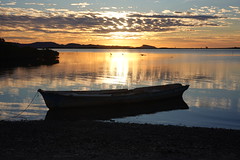 You will definitely find Baja to be more primitive – services are harder to come by, roads are narrow with speed bumps that can take out your vehicle if you don’t respect them. Shops are rougher with limited selection. A sidewalk could just have a hole going down to a valve, with no warning. But somehow Baja feels more free. There are not a zillion signs telling what not to do, and the rules you do get are less restrictive. If you’re picky and like knowing exactly where you stand, Baja is probably not for you. If you’re adaptable, and are willing to live in the grey zone to get a bit more freedom, Baja may be your place. If you’re not sure, try the run down Highway 5 to San Felipe. You’ll get a little taste of Baja, and have the option of anything from boondocking to full service camping along the way. After a margarita or two on the beach, you may find yourself heading further south. I think I’ll be south of there again sometime in my future. In the meanwhile, I’ll leave you with a few more of my favorite pictures. You can see the full set in my Baja 2024 travels on Flickr. Next time, onto Texas for real!
You will definitely find Baja to be more primitive – services are harder to come by, roads are narrow with speed bumps that can take out your vehicle if you don’t respect them. Shops are rougher with limited selection. A sidewalk could just have a hole going down to a valve, with no warning. But somehow Baja feels more free. There are not a zillion signs telling what not to do, and the rules you do get are less restrictive. If you’re picky and like knowing exactly where you stand, Baja is probably not for you. If you’re adaptable, and are willing to live in the grey zone to get a bit more freedom, Baja may be your place. If you’re not sure, try the run down Highway 5 to San Felipe. You’ll get a little taste of Baja, and have the option of anything from boondocking to full service camping along the way. After a margarita or two on the beach, you may find yourself heading further south. I think I’ll be south of there again sometime in my future. In the meanwhile, I’ll leave you with a few more of my favorite pictures. You can see the full set in my Baja 2024 travels on Flickr. Next time, onto Texas for real!


